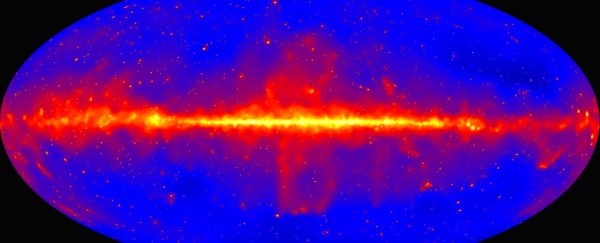The centre of the Milky Way is glowing. Yes, there's a big chonkin' black hole there, and it's a very energetic region, but there's an additional high-energy, gamma-ray glow, above and beyond the activity we know about, and it's something that's yet to be explained.
This glow is called the Galactic Center GeV Excess (GCE), and astronomers have been trying to figure it out for years. One hotly debated explanation is that the glow might theoretically be produced by the annihilation of dark matter - but new research is a nail in that idea's coffin.
In a series of exhaustive models that include recent developments in simulating the galactic bulge and other sources of gamma-ray emission in the galactic centre, a team of astrophysicists have ruled out dark matter annihilation as the source of the glow.
This finding, the team says, gives dark matter less room to hide - placing stronger constraints on its properties that could aid in future searches.
"For 40 years or so, the leading candidate for dark matter among particle physicists was a thermal, weakly interacting and weak-scale particle," said astrophysicist Kevork Abazajian of the University of California Irvine (UCI).
"This result for the first time rules out that candidate up to very high-mass particles."
The GCE was first noticed a little over a decade ago, when the Fermi Gamma-ray Space Telescope started surveying the region. Gamma rays are the highest-energy electromagnetic waves in the Universe, and they are produced by the most intense objects, such as millisecond pulsars, neutron stars, colliding neutron stars, black holes, and supernovae.
The problem was, when it came time to analyse Fermi's observations, after all known gamma-ray sources were subtracted, we ended up with a gamma-ray glow in the heart of the Milky Way that couldn't be accounted for.
In space, when you find something that can't be accounted for, it makes sense to try to match it up with other things that can't be accounted for - like dark matter. This is the name we give to the invisible mass that adds gravity to the Universe.
We can detect dark matter indirectly, because things move differently from how they should if only the visible stuff was having an effect, but we don't know what it actually is.
However, while we can't detect dark matter directly, it's possible that it produces radiation we can see.
If types of dark matter particles called Weakly Interacting Massive Particles, or WIMPs, were to collide with each other - like the collisions in particle accelerators - they would annihilate each other, exploding in a shower of other particles, including gamma-ray photons. Such collisions have been put forward as a potential mechanism producing the GCE.
Several studies, however, have found no evidence of WIMP collisions, but this new paper is a step up, the authors say.
"In many models, this particle ranges from 10 to 1,000 times the mass of a proton, with more massive particles being less attractive theoretically as a dark matter particle," said UCI astrophysicist Manoj Kaplinghat.
"In this paper, we're eliminating dark matter candidates over the favoured range, which is a huge improvement in the constraints we put on the possibilities that these are representative of dark matter."
Over three years, the team pulled together a wide range of gamma-ray modelling scenarios for the galactic centre and its bulge - the tightly packed group of stars concentrated around the centre. They included all the sources they could get their hands on - star formation, the Fermi bubbles, cosmic-ray interactions with molecular gas, and neutron stars and millisecond pulsars.
They found that, once they had factored everything in, there was very little room left for WIMP annihilation. Between all these gamma-ray sources, "there is no significant excess in the GC that may be attributed to DM annihilation," the researchers write in their paper.
Previous research has found that the distribution of gamma-rays in the galactic centre is also inconsistent with dark matter annihilation. If WIMPs were the culprit, the distribution would be smooth - but instead, the gamma-ray photons are distributed in clumps as you'd expect to find from point sources, like stars.
The distribution of stars in the bulge, according to the new research, is also inconsistent with the presence of additional dark matter.
That's not to say the dark matter in our galactic centre couldn't be of some hypothetical, massive, weakly interactive type. The team has just ruled those of a mass commonly searched for, and then some. The team notes that their findings still strongly favour an astrophysical origin for the GCE.
"Our study constrains the kind of particle that dark matter could be," Kaplinghat said. "The multiple lines of evidence for dark matter in the galaxy are robust and unaffected by our work."
Which means we're just going to have to think a lot farther outside the box to find it.
The research has been published in Physical Review D.
